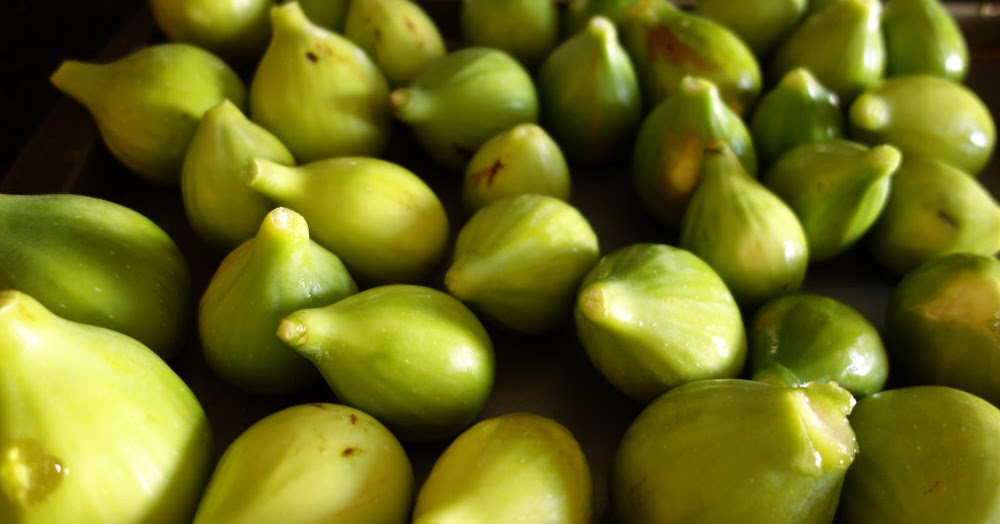Figs, fresh-picked from the trees
I really enjoy this time of year when figs are ripening on the trees and plentiful. Yesterday I came across a small cluster of fig trees growing wild on a tiny strip of public land where a couple streets meet at an intersection (barely a 2-foot wide area between an alley and a larger road). These trees, which are approximately 15 feet tall and 10 feet in diameter must each literally have a thousand figs on them right now!
I only noticed the trees because so many figs had fallen to the ground that they caught my attention when I accidentally stepped on one and it squished everywhere. It only took a few minutes to harvest some five pounds (2-3 Kg) of fresh figs…
| Fresh Figs from the tree |
Although these figs look rather green in color yet, the ones that were just slightly more yellow in color than some others were quite soft and ripe already, and their inner seeds are already turning a brown-sugar brown color…
 |
| Fresh Fig : center showing ripeness |
Of course figs are safe for a gluten-free diet,… they are just a fruit, and a really tasty fruit at that. And, figs are quite versatile and can be included in a wide range of gluten-free recipes in addition to being consumed fresh. These figs have a wonderful natural sweetness, and are naturally high in fiber (~14{5676e3b156b07d12bd9df9fe13d641a85da396026abde11a1ff2d0afc1b3c015} by weight, raw).
The only thing that may take a bit of getting use to is the rather light, fluffy texture of a fresh fig. If for any reason you do not care for the texture of fresh figs, simply consider frying them or baking them, or cooking them down into a lovely fig jam or paste. Since I will have more figs than I can possibly consume fresh (they tend to quickly ripen!), I will certainly be cooking some of them.
Recommended Preparations / Uses for Figs
You can dry / dehydrate the figs for longer term storage, if you have a way to do so. I generally purchase my dried figs from the store. I really like dried figs in my morning granola or for simple snacking. But, I also like to prepare fig paste: simply cook the whole figs down in a sauce pan, add just a touch of cinnamon and vanilla, and keep a jar of this around, like jam, to add to greek yogurt, use as a spread to accompany various cheeses, or even place on top of a square of nice dark chocolate! This fig preparation can even add a nice tone to some salad dressings.
Next, try baking or frying some fresh figs. I typically do this in a cast-iron pan either on the stove top or in the oven. Split the figs in half, vertically, place them cut-side down in a pan that has been lightly sprayed or coated with oil, and sprinkle just a light dusting of cinnamon over them. Fry or roast until the sugars in the figs caramelize nicely. If for some reason the natural sweetness of the figs is not sufficient for your liking, just add a slight bit of brown-sugar. Optionally, instead of a light coating of cooking spray, use a bit of butter to enrich and enhance the flavors. The end result (the lovely baked / fried figs) can be served as is, for a dessert item, or provide the finishing touch to fancier and more complex desserts or dishes — perhaps over ice-cream, on top of your favorite gluten-free cake, or even as a salad accent.
For pricing purposes, if you cannot find fresh figs just growing wild, I have seen them in the local grocery stores in the area lately for between EUR 3 and EUR 5 per Kilogram (i.e., in US Dollar terms, that is essentially $1.50 – 2.50 per pound), and keep in mind that the figs are not terribly heavy. They are delicate when ripe, so remember not to pile other groceries on top of them unless you want raw-fig-paste accidentally.
Continue to read this Gluten-Free Blog for all sorts of gluten-free recipes, product-reviews, and related information. In addition, visit my Gluten-Free Recipes Site where many of the recipes I have featured on this blog are available.



